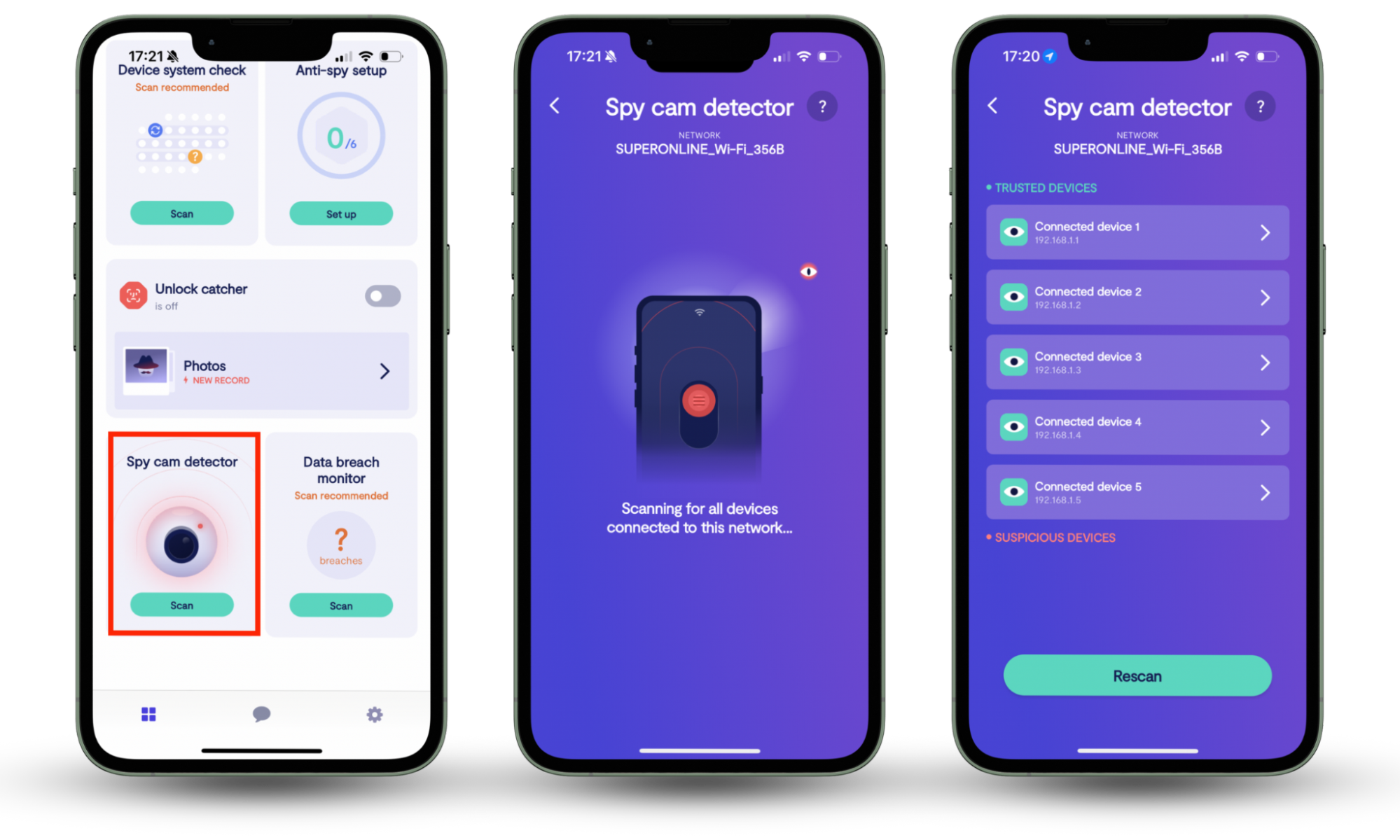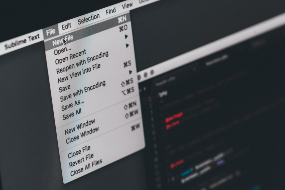Table of contents
- What are hidden cameras?
- Why do people use hidden cameras?
- Where are hidden cameras found?
- Most common places to spot hidden cameras
- Is it legal to use hidden cameras?
- What do hidden cameras look like?
- Hidden camera in screws
- USB charger spy cameras
- Hidden camera in a smoke detector
- Other typical spy cameras
- How to detect hidden cameras
- Scan the environment carefully
- Consider the best angle for coverage in a room
- Understand what part of the camera to look for
- Check for keyholes, holes, or unusual objects
- Check stuffed animals and clocks
- Check the mirrors
- Use your smartphone camera
- Scan the Wi-Fi network
- Use a phone call to detect interference
- Use a hidden camera detector app
- Use a specialized RF detector
- Hire a professional technician
- What to do if you find a hidden camera?
- Don't move or touch the hidden cameras
- Remove all your belongings from the camera's view
- Take pictures of the camera for evidence
- Call the police or other authorities to investigate the case
- Conclusion
What are hidden cameras?
Hidden cameras are recording devices designed to be discreet and difficult to detect. They’re often used for surveillance purposes, as they can be placed in a variety of locations to capture people or events without their knowledge. Though they usually capture video footage, some can record audio too.
Hidden cameras come in many forms. Tiny cameras can be hidden in everyday objects, like pens, smoke detectors, and toys. If a laptop camera is hacked, it can also function as one. Hidden cameras can also be integrated into businesses or organizations' larger, more sophisticated surveillance systems.
Why do people use hidden cameras?
The reasons why people use hidden cameras are as varied as the cameras themselves. Here are some common reasons:
- Security: Hidden cameras can monitor a home or business for potential security threats, such as burglaries and vandalism. In the event of a crime, hidden cameras can identify the perpetrators.
- Surveillance: Hidden cameras can monitor employees, children, or anyone else for reasons such as monitoring productivity or watching over loved ones.
- Investigations: Law enforcement and private investigators can use hidden cameras to gather evidence for criminal cases or other investigations.
- Entertainment: Hidden cameras can be used to film pranks or hidden camera shows.
- Personal safety: Hidden cameras can be used to ensure personal safety by monitoring for potential threats or abusive behavior.
There are also illegitimate reasons why people use hidden cameras. The covert technology can be used to spy on people without their knowledge or consent. Here are some unethical reasons why people use hidden cameras:
- Theft: Hidden cameras can be used to gather private data for financial or identity theft. They can be used to steal business secrets and intellectual property. They can also be used to track and steal physical property.
- Voyeurism: Some people use hidden cameras to spy on others for sexual gratification. The footage can also be sold online on the dark web.
- Blackmail: Hidden cameras can be used to capture compromising footage of individuals in order to blackmail them for money, information, or other favors.
It’s important to use hidden cameras responsibly and in accordance with the law—more on that below.
Where are hidden cameras found?
As hidden cameras technology gets more sophisticated, they are becoming increasingly prevalent in all spheres of life—some of which may surprise you.
Here are some locations where hidden cameras can be found:
- Hotel rooms: Hidden cameras can be placed in hotel rooms and AirBnBs to spy on guests.
- Public restrooms: Hidden cameras can sometimes be found in public restrooms to capture footage of individuals using the facilities.
- Changing rooms: Changing rooms of stores or gyms are a potential spot for hidden cameras capturing people changing.
- Offices: Hidden cameras can be placed in offices or workplaces to watch employees. Generally, employers are required to get consent from their workers beforehand.
- Homes: Hidden cameras in homes are generally used for surveillance protection. However, some homeowners use them to monitor house workers or caregivers.
Most common places to spot hidden cameras
By definition, hidden cameras must be out of sight, so where they are placed is key to their effectiveness. Though they can be hidden in crazy, clever places, like keyholes, they usually still require a connection to a power supply.
Here are the most common places to spot hidden cameras:
- Screws
- USB chargers
- Smoke detectors
- Keyholes and other small holes
- Stuffed animals and toys
- Bookshelves and books
- Clocks
- Wall decor
- Air filters and other utilities.
Spying cameras can be disguised as everyday objects, like smoke detectors, clocks, or even USB chargers. This makes them nearly impossible to spot with the naked eye, posing significant risks to your privacy. Footage from hidden cameras can be uploaded online or sold, leading to severe privacy violations. Hackers can even use the collected information to blackmail you. Also, knowing your private space has been compromised can cause anxiety and a loss of feeling of safety in your home.
But there are ways to protect yourself. Clario Anti Spy is a cybersecurity solution designed to enhance users' digital safety. Our Spy cam detector feature scans and identifies all devices connected to your Wi-Fi network, helping you detect any disguised cameras that may be secretly watching you.
Here’s how to use Clario Anti Spy’s Spy cam detector:
- Download Clario Anti Spy on your mobile device.
- Create an account.
- Locate Spy cam detector feature and tap Scan.
- The app will now scan all devices connected to your Wi-Fi network.

Is it legal to use hidden cameras?
The legality of hidden cameras depends on jurisdiction and the circumstances of their usage. Generally, it’s legal to use hidden cameras in public places where individuals don’t have a reasonable expectation of privacy, like on a street. Using them to record individuals in private places, like homes or hotel rooms, is generally illegal.
Hidden cameras are usually restricted in a workplace. Employers may have to obtain the consent of their employees before they can start monitoring their activity.
It’s important to understand the laws about hidden cameras in your area. Illegal hidden camera usage could result in serious legal consequences, including criminal charges.
What do hidden cameras look like?
Since they can be hidden in a variety of places and objects, hidden cameras can come in many different shapes and sizes.
Here are some common objects that conceal hidden cameras:
- Hidden cameras in the screws
- USB charger spy cameras
- Hidden camera in a smoke detector
- Other typical spy cameras.
Let’s zoom in on these various types of hidden cameras:
Hidden camera in screws
That’s right, there are hidden cameras small enough to fit into the head of a screw or in a screw hole. They are super discreet and especially hard to spot since they can be mixed in with regular screws on a piece of furniture or gadget.
USB charger spy cameras
In the smartphone age, USB chargers are nearly ubiquitous—so they’re a perfect masquerade for a hidden camera. Usually, these cameras capture footage of the surrounding area and record audio as well.
Hidden camera in a smoke detector
Smoke detectors are commonly found in homes, offices, and other buildings, so they make a great cover for hidden cameras. They’re either hidden inside smoke detector units or designed to look like one. They usually record both video and audio.
Other typical spy cameras
Like the examples above, other spy cameras are often designed to look like everyday objects, making it difficult to know if a camera is watching you. Hidden cameras can appear like buttons, books, eyeglasses, a necktie, or a plant. Hackers can also see you through your phone camera, effectively turning it into a spying device.
How to detect hidden cameras
It can be challenging to locate hidden cameras because they’re designed to blend in with their environment. However, if you know what to look for, you may be able to catch them—before they catch you.
Here are some ways to check for hidden cameras:
- Scan the environment carefully
- Consider the best angle for coverage in a room
- Understand what part of the camera to look for
- Use a flashlight
- Check for keyholes, holes or unusual objects
- Check stuffed animals and clocks
- Check the mirrors
- Use your smartphone camera
- Scan the Wi-Fi network
- Use a phone call to detect interference
- Use a hidden camera detector app
- Use a specialized RF detector
- Hire a professional technician
Let’s dig a little deeper into these tried and tested strategies:
Scan the environment carefully
Take a good look at the space in question and the objects within it. Though hidden cameras appear ordinary, there’s always something “off” about them. Look out for anything that’s incongruous with the rest of the space. In particular, pay close attention to the everyday, seemingly normal stuff.
Consider the best angle for coverage in a room
To look for hidden cameras, you must “see” like them. Where would you be located to get the best view of a room? Once you figure that out, start your search from there. Just like with CCTV or surveillance cameras, corners of rooms usually provide the best coverage for hidden cameras.
Understand what part of the camera to look for
Though wires and cables might be hidden, the lens of a spy camera still needs to be exposed in order to capture an image. If it can see you, then you can see it. Like a regular camera lens, look for a circular, glassy object.
Use a flashlight
Because lenses are made with glass or glass-like material, they easily reflect the light of a flashlight. Shine a light in a room and look for any reflections that suggest a camera lens. Hidden camera lenses may reflect light differently than other objects.
Check for keyholes, holes, or unusual objects
Keyholes or other small crevices are inconspicuous spots to look for hidden cameras. But before you start questioning every little hole you see, remember that spy cameras need a connection to a power supply, so these spaces are not ideal for placing cameras.
Check stuffed animals and clocks
A cuddly teddy bear or wall clock may seem harmless enough, but they are common places to hide hidden cameras. Pay particular attention to small details, like screws or the eyes of toys. Conveniently for you, these items are easy to move. So if you suspect a hidden camera, move the object out of sight—but remember, it could record audio too.
Check the mirrors
If you see mirrors in unusual places within a space—like in a kitchen or living room—it could be hiding a spy camera. Because mirrors are reflective, they may evade detection when you look for hidden cameras. Two-way mirrors are especially suspicious.
Use your smartphone camera
A common way to find hidden camera with phone is by detecting infrared light. Most hidden cameras emit infrared light when functioning. It’s invisible to the naked eye, but not to some smartphone cameras. If your phone can detect infrared light, take a picture of the object or space in question, and see if it picks up any light. To test if your phone can detect infrared light, take a picture of a remote control’s front LED with your front-facing phone camera.
Scan the Wi-Fi network
A Wi-Fi scan can only detect a hidden camera if it’s wireless and connected to the same network as you. Since there are many types of cameras that aren’t oriented like this, scanning the Wi-Fi network isn’t always an effective way to look for hidden cameras. But it’s worth a shot and may save you the headache of physically finding the device.
With Clario Anti Spy’s Spy сam detector, you can easily scan your Wi-Fi network to identify all connected devices, including any disguised cameras that might be secretly recording you.
Use a phone call to detect interference
Hidden cameras can potentially disrupt the signal to your phone, resulting in hissing, buzzing, and other disruptive sounds. You can search for hidden cameras by calling someone and walking around the space until you experience signal interference.
Use a hidden camera detector app
Specialized detector apps use a variety of tools to find hidden cameras, like radiofrequency, infrared, and lens glare detection, and network scanning. The combination of methods increases their efficacy and saves you time from trying all these methods manually.
Use a specialized RF detector
A specialized RF detector is a device that’s extremely sensitive to the radio frequencies emitted by wireless cameras. When it detects a signal, it will sound an alarm or display a signal strength indicator, which helps you locate the device. Though a powerful device, it’s not always effective since not all hidden cameras emit radio frequency signals.
Hire a professional technician
A professional technician who specializes in finding hidden cameras will have the techniques and technology to thoroughly search and locate any hidden cameras that may be present. Surveillance technology is constantly evolving; a qualified professional will keep up with the changes and deliver definitive results.
What to do if you find a hidden camera?
Finding a hidden camera can be shocking and unsettling, especially if it’s in a private space. Whether at home, work, or public area, being recorded by a hidden camera can be a violation of the law. Although your first instinct might be to immediately remove it, it’s crucial to take appropriate actions.
Here’s what to do if you find a hidden camera:
- Don't move or touch the hidden cameras
- Remove all your belongings from the camera's view
- Take pictures of the camera for evidence
- Call the police or other authorities to investigate the case
Let’s take a closer look at these steps.
Don't move or touch the hidden cameras
The footage on a hidden camera can serve as valuable evidence if you’re being recorded illegally. Moving or touching hidden cameras can destroy the footage, along with the evidence of the possible crime. Law enforcement can also collect fingerprints and other evidence from hidden cameras.
Remove all your belongings from the camera's view
Removing your belongings from the camera’s view ensures that no further personal data will be collected from you. You may not know the motives of why someone is watching you—or your things. They could be trying to glimpse at personal documents and steal your data.
Take pictures of the camera for evidence
Taking pictures of the camera for evidence will help you build your case if it turns out that a crime is being committed. It’s also a good idea to take pictures of the surrounding area. Any and all documentation of the space can be used to help you in a courtroom.
Call the police or other authorities to investigate the case
Report the discovery of a hidden camera to the police and other authorities. They have the skills and technology to investigate the matter and proceed with possible prosecution properly. If you don’t know who’s responsible for the hidden camera, law enforcement may be able to track down the culprit.
Conclusion
Hidden cameras are everywhere—but the right tips and tricks can help you detect them and protect your privacy. Check the most common places for hidden cameras first. These include smoke detectors, USB chargers, stuffed animals and toys, bookshelves, clocks, wall decor, etc. Then, use Clario Anti Spy’s Spy cam detector to check your Wi-Fi network and see if any unfamiliar devices are connected, potentially spying on you.


